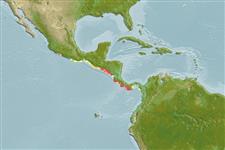Classificação / Names
Nomes comuns | Sinônimos | Catalog of Fishes(Gênero, Espécies) | ITIS | CoL | WoRMS | Cloffa
>
Siluriformes (Catfishes) >
Ariidae (Sea catfishes) > Ariinae
Etymology: biffi: Named for Dr. Eldredge (Biff) Bermingham (STRI), for his important contribution to the knowledge of neotropical fish biogeography..
Environment: milieu / climate zone / depth range / distribution range
Ecologia
marinhas; estuarina bentopelágico; intervalo de profundidade 9 - 30 m (Ref. 54794). Tropical
Eastern Central Pacific: tropical Eastern Pacific from central and north Costa Rica and El Salvador. Although Kailola and Bussing (1995) speculate that “Arius” species A extends southwards to Panamá, R. Cooke (pers. comm., 2004) doubts that this species is present in Panamá, at least from Parita Bay eastwards (Ref 54794).
Tamanho / Peso / Idade
Maturity: Lm ? range ? - ? cm
Max length : 32.4 cm SL macho/indeterminado; (Ref. 54794)
Descrição suscinta
Chaves de identificação | Morfologia | Morfometria
Notarius biffi is distinguished from other EP species of Notarius by the following combination of features: a small mouth, its width 34.2–39.3% (mean 36.2%) HL; eye large, its diameter 3.8–4.5% (mean 4.2%); short mandibulary barbels, their length 10.2–13.1% (mean 11.6%) SL; short anterior internarial distance, 17.9–20.8% (mean 19.4%) HL; relatively slender caudal peduncle, depth 6.1–6.7% (mean 6.4%) SL; and gill rakers on first arch 3–4+7–8 (mode 12). The combination of the following characters also distinguish this species from other EP ariids: triangular humeral process, three pairs of barbels present, fleshy furrow between posterior nostrils absent, fleshy groove in median depression of head absent, coarse to sharp granules or spinulations on anterior surface of head shield absent, and gill rakers on rear surfaces of first two gill arches absent (Ref 54794).
Inshore marine and brackish waters, and high salinity estuaries (Ref 54794).
Ciclo de vida ou comportamento de acasalamento
Maturities | Reprodução | Spawnings | Egg(s) | Fecundities | Larvas
Betancur-R., R. and A. Acero P., 2004. Description of Notarius biffi n. sp. and redescription of N. insculptus (Jordan and Gilbert) (Siluriformes: Ariidae) from the eastern Pacific, with evidence of monophyly and limits of Notarius. Zootaxa 703:1-20. (Ref. 54794)
Status na Lista Vermelha da UICN (Ref. 130435)
Ameaça para os humanos
Traumatogenic (Ref. 58010)
Uso pelos humanos
Ferramentas
Relatórios especiais
Baixar XML
Fontes da internet
Estimates based on models
Preferred temperature (Ref.
123201): 24.5 - 29.1, mean 27.9 °C (based on 20 cells).
Índice de diversidade filogenética (Ref.
82804): PD
50 = 0.5002 [Uniqueness, from 0.5 = low to 2.0 = high].
Bayesian length-weight: a=0.01000 (0.00244 - 0.04107), b=3.04 (2.81 - 3.27), in cm total length, based on all LWR estimates for this body shape (Ref.
93245).
Nível Trófico (Ref.
69278): 3.5 ±0.4 se; based on size and trophs of closest relatives
Resiliência (Ref.
120179): médio(a), tempo mínimo de duplicação da população 1,4 - 4,4 anos (Preliminary K or Fecundity.).
Fishing Vulnerability (Ref.
59153): Low to moderate vulnerability (30 of 100).
